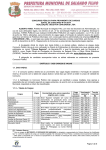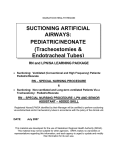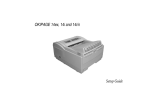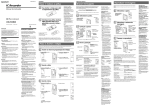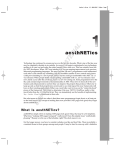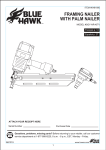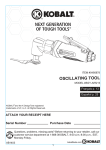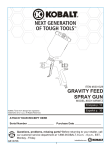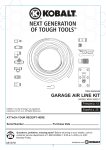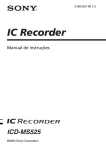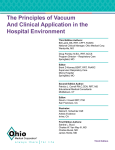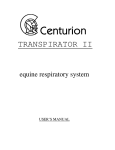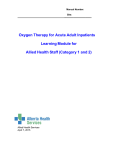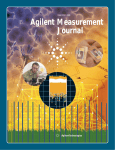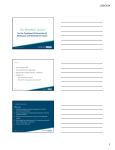Download Tracheostomy Care and Suctioning - Adult
Transcript
SASKATOON HEALTH REGION SUCTIONING ARTIFICIAL AIRWAYS in ADULTS Tracheostomies and Endotracheal Tubes RN AND LPN LEARNING PACKAGE RN – SPECIAL NURSING PROCEDURES Suctioning Non-Ventilated Adult Patients with an Artificial Airway in Place Suctioning Ventilated Adult Patients & LPN – ADDED SKILL Suctioning a Non-ventilated Adult patient via a Tracheostomy Tube in a Well-Healed Stoma Registered Nurses and Licensed Practical Nurses identified by their Manager will be certified to perform suctioning via endotracheal and/or tracheostomy tubes in accordance with the policy of the clinical unit. DATE: June 2005 *Pediatric information removed May 2010 This material was developed for the use of Saskatoon Regional Health Authority (SRHA). This material may not be suitable for other agencies. SRHA makes no warranties or representations regarding this information, and each agency is urged to update and modify this information for its own use. Suctioning Artificial Airways Learning Package i Permission for extensive copying of this learning package for scholarly purposes may be granted. It is understood that due recognition will be given to the Coordinator(s) of this learning package and to the Department of Nursing Affairs in any use of this material. Copying, publication or any other use of this learning package for financial gain without approval is prohibited. Requests for permission to copy or to make other use of this material in this learning package, in whole or in part, should be addressed to: Department of Nursing Affairs c/o Nursing Affairs Office Royal University Hospital Saskatoon, SK S7N 0W8 c/o Nursing Affairs Office Saskatoon City Hospital Saskatoon, SK S7K 0M7 c/o Nursing Affairs Office St. Paul’s Hospital Saskatoon, SK S7M 0Z9 ACKNOWLEDGEMENTS: Coordinated by: Chrystal Grant Clinical Nurse Educator, Rehabilitation Unit Saskatoon City Hospital Evelyn Seip Clinical Nurse Educator, Intensive Care Unit Saskatoon City Hospital *Pediatric information removed by Bernie McDonald May 2010. Pediatric information is included in Suctioning Artificial Airways: Pediatric/Neonate learning package. Special Thanks to: Ann Burton Clinical Nurse Specialist Parkridge Centre Margot Hawke Clinical Nurse Educator St. Paul’s Hospital/Royal University Hospital Helen Sabadash Clinical Nurse Educator Royal University Hospital/Saskatoon City Hospital Clinical Nurse Educators Acute Care Sector, Saskatoon Health Region Site Representatives for Acute Care Sector, Saskatoon Health Region Respiratory Therapy and Physiotherapy S:\Nursing Office\LEARNING PKG\suctioning artificial airways - adults.doc Suctioning Artificial Airways Learning Package ii TABLE OF CONTENTS 1.0 General Information................................................................................. 1 1.1. Criteria for Certification....................................................................... 1 1.2. Criteria for Recertification................................................................... 1 2.0 Theory....................................................................................................... 2 2.1. Assessing the Need for Suctioning .................................................... 2 2.2. Preparing the Patient and Equipment for Suctioning.......................... 3 2.3. Complications of Tracheal Suctioning ................................................ 8 3.0 References ............................................................................................... 11 4.0 Appendix A. Policies ................................................................................................. 12 B. Respiratory System – Anatomy & Physiology ...................................... 15 C. Artificial Airways ................................................................................... 19 5.0 Review Questions.................................................................................... 23 S:\Nursing Office\LEARNING PKG\suctioning artificial airways - adults.doc Suctioning Artificial Airways Learning Package 1 1.0 GENERAL INFORMATION 1.1. Criteria for Certification Review of the learning package and completion of the review questions. Satisfactory demonstration of the clinical skills to a Clinical Nurse Educator in a patient and/or lab setting. 1.2. Criteria for Recertification Recertification is required annually for LPNs who are not performing the skill regularly. Recertification is recommended for RNs annually if the skill is not used regularly. Recertification may be done upon the request of the Manager of Nursing, Clinical Nurse Educator or the individual RN or LPN. S:\Nursing Office\LEARNING PKG\suctioning artificial airways - adults.doc Suctioning Artificial Airways Learning Package 2 2.0 THEORY 2.1. Assessing the Need for Suctioning A patient with a tracheostomy or endotracheal tube is less able to increase intrathoracic pressure for an effective cough to clear secretions. This is because the artificial airway holds the vocal cords open which normally close just prior to a cough. Initially, a tracheostomy tube may cause increased secretions due to irritation. Since tracheal suctioning may cause complications, suctioning should be done only when there is exudate present in the upper airways, which the patient is unable to clear by coughing. Routine suctioning should be avoided as this will increase chance of mucosal trauma and risk of infection. Remember that crackles and wheezes are rarely cleared with suctioning because they indicate obstruction or fluid in the lower airways, which are inaccessible to suctioning. Chest physiotherapy and positioning may move fluid from the lower airways, making it more accessible to suctioning. Humidification of inspired air and systemic hydration assist to: Keep secretions thin, easier to move/remove Reduce need for suctioning if patient can raise own secretions Prevent tube occlusion from thick/dried secretions Counteract insensible fluid losses Compensate for bypass of upper airway Maintain moist mucous membranes to maximize mucocilliary transport in the lower airways Complications of decreased humification are: atelectasis, tracheitis, pulmonary infection, obstruction, death Complications of over humidification are: excessive moisture into dependent bronchi, tracheal burns if humidity temperature is excessive, infection The need for suctioning varies from patient to patient, and with patient condition. For example: a patient with pneumonia and copious secretions may need to be suctioned every 10 minutes to maintain airway patency and allow for ventilation. On the other hand, a patient without lung disease, who has been intubated only for ventilation, i.e. neuromuscular disease, may need to be suctioned only once a shift. 2.1.1. Signs and Symptoms Indicating a Need for Suctioning Dyspnea, tachypnea, apnea Change in respiratory pattern Increased respiratory rate Change in heart rate and rhythm S:\Nursing Office\LEARNING PKG\suctioning artificial airways - adults.doc Suctioning Artificial Airways Learning Package 3 Restless and agitation Noisy respirations/abnormal breath sounds: gurgling, wheezing, crackles Decreased Sp02 or deterioration of blood gases Deterioration in patient’s color, cool skin Use of accessory muscles, nostril flaring Ineffective coughing Patients with the following conditions are more likely to react adversely to suctioning. Suction these patients with caution. Increased intracranial pressure Hemodynamic instability Recent surgery to the chest and pulmonary structures Pulmonary hemorrhage Extreme reactive bradycardia (i.e. when the heart rate drops dramatically in response to suctioning) Hyperactive airways Contraindications to suctioning: Epiglottis and/or croup are absolute contraindication for nasotracheal suctioning since suctioning can worsen these conditions Nasal bleeding Occluded nasal passages Coagulaopathy or bleeding disorder Laryngospasm Irritable airway Upper respiratory tract infection 2.2. Preparing the Patient and Equipment for Suctioning 2.2.1. Preparing the Patient Suctioning is an uncomfortable and often frightening procedure: The patient is intubated and is therefore unable to vocalize The presence of the catheter in the trachea may make the patient highly anxious and restless Suctioning may cause hypoxemia The patient may have a smothered feeling Patients have rated the pain of suctioning at 7 on a pain scale of 110 (Puntillo, 2001) An explanation regarding the purpose of tracheal suctioning should be given to the patient and/or family prior to suctioning and throughout the procedure each time the procedure is done. Important points to tell the patient and family include: Why the patient requires specific aspects of care (i.e. intubation, suctioning, oxygen before the procedure, instillation of saline) S:\Nursing Office\LEARNING PKG\suctioning artificial airways - adults.doc Suctioning Artificial Airways Learning Package 4 Comfort measures taken Any other aspects of care regarding the individual needs of the patient The patient may benefit from frequent reassurance and instruction on how to assist the nurse during the procedure. Often during the procedure, the patient instinctively wants to pull at the catheter, especially when the cough reflex is stimulated. Warn the patient that the procedure will make him/her cough. Restraints may be necessary, especially in the cognitively impaired patients, and with children. To allay patient fears, suctioning must be performed with confidence and speed. Positioning the Patient Position the patient with head of bed elevated or in appropriate position for postural drainage unless medically contraindicated (i.e. unstable spinal fractures). Rationale: This promotes deep breathing and effective coughing by allowing maximum movement of the diaphragm. Oxygenation If required, extra oxygen may be given before and after each episode of suctioning. This is most often done with ventilated patients. In the nonventilated patient, extra oxygen can be provided using a manual resuscitation bag attached to oxygen or increase oxygen flow, if needed. If extra oxygen is not needed, encourage the patient to take several deep breaths before and after suctioning. Hyperoxygenation Hyperoxygenation refers to the administration of oxygen at a greater concentration than the patient is receiving or usually requires. It is performed before, during, and after suctioning, based on assessment of the patient’s respiratory status. Hyperoxygenation can be performed by an assistant giving 5 – 6 ventilations using a resuscitation bag with supplemental 02, or by the patient taking several large breaths while receiving a higher than normal concentration of oxygen, or in the ventilated patient by increasing the ventilator Fi02. Note: to hyperoxygenate by ventilator requires 1 – 2 minutes before dead space in the ventilator is cleared. Rationale: It is well documented that a decrease in arterial oxygenation occurs during the tracheal suctioning procedure. The decreased arterial oxygen tension following tracheal suctioning has been found to lead to S:\Nursing Office\LEARNING PKG\suctioning artificial airways - adults.doc Suctioning Artificial Airways Learning Package 5 cardiac dysrhythmias, hypotension, and death. Tachycardia may occur as a reflex response to compensate for the suction-induced hypoxemia. Hyperoxygenation minimizes suction-induced hypoxemia by maintaining the Pa02 levels throughout the suctioning period. Manual ventilation (like mechanical ventilation) also minimizes hypoxemia due to suctioning-induced atelectasis, by re-expanding sections of the lungs that may have been evacuated or air and collapsed. 2.2.2. Preparing the Equipment Suction Catheter The catheter size will vary depending on the size of the airway: Adults #12 – 14 Fr. catheters CORRESPONDING SIZES CUFFED/UNCUFFED SHILEY 00 0 1 2 3 4 4 4 4 6 8 10 METAL LAERDAL ADAPTOR 4 5 6 7 8 5 6 7 8 9 SUCTION CATHETER 5 8 8 10 10 10 10 12 12 12 14 14 The catheter size should be no more than ½ the diameter of the airway. If the airway is fully occluded with the catheter it may cause a drop in Pa02. In addition, large catheters and small interior diameter of artificial airways, when coupled with higher suction flow rates, produce the greatest negative airway pressures and alveolar collapse. Catheter size can contribute to suction-induced atelectasis, hypoxia, intrapulmonary shunting and decreased lung compliance. Catheters with multiple openings versus a single opening produce less tissue trauma. (Egan, 1995) The catheter may also stimulate the vagus nerve, resulting in bradycardia and hypotension. Paroxysmal coughing due to catheter irritation increases intrathoracic pressure, decreases venous return and produces transient hypotension and syncope. It also increases intracranial pressure and reduces cerebral blood flow. Cardiac arrhythmias may occur due to decrease in myocardial oxygen supply or S:\Nursing Office\LEARNING PKG\suctioning artificial airways - adults.doc Suctioning Artificial Airways Learning Package 6 increase in oxygen demands in the presence of accompanying tachycardia and elevated blood pressure. Suction Catheter – Closed System In ventilated patients, a closed-circuit catheter system eliminates the need to disconnect the patient from the ventilator during suctioning. The severity of arterial oxygen desaturation can be reduced by using a closed system, and unstable patients appear to better tolerate suctioning when not removed from ventilatory (Maggione, pg 1218, 2003). Refer to Policy and Procedure: Suctioning Adult Patients With Artificial Airways in Place #1019 for further information. S:\Nursing Office\LEARNING PKG\suctioning artificial airways - adults.doc Suctioning Artificial Airways Learning Package 7 Suction Trap Used to collect sterile sputum specimens when the patient is unable to expectorate sputum or has an artificial airway in place. The sputum trap is placed between the suction catheter and the suction tubing. Please see SHR Infection Prevention and Control Manual and Laboratory Service Manual for further information regarding use of sputum traps. Setting the Suction Pressure Set suction pressure at: 100 – 120 mmHg for adults Adjust the suction pressure according to the nature of the secretions being removed. Use the lowest suction pressure that will be effective. Thick secretions or mucous plugs may necessitate higher pressures. A physician’s order is required to increase the pressure above the limits identified above. Rationale: Damage to the epithelial and mucosal layers of the airways caused by the presence of an artificial airway is magnified with the introduction of a suction catheter. Excessive vacuum causes edema, hemorrhage, and ulceration of tracheal tissue. It can pull air from distal airways and contributes to atelectasis and decreased lung compliance. It has not been found to increase the amount of secretions retrieved. Instillation of Sterile Normal Saline The instillation of sterile NS should not be done on a routine basis. (Ridling, 2003) Instillation can contaminate the lower airways and has an adverse effect on oxygen saturation and arterial blood gases. Adequate systemic hydration and airway humidification may accomplish more than instillation (see page 2). Normal saline and secretions don’t S:\Nursing Office\LEARNING PKG\suctioning artificial airways - adults.doc Suctioning Artificial Airways Learning Package 8 blend when mixed together and therefore the secretions aren’t thinned for easier suctioning. (Day et al, 2001). Assess the need for instillation. If required, instill sterile Normal Saline into the tube, during inspiration: 3 – 5 ml (adult) Side effects of instillation are: Decreased PaO2 Failure to remove all saline Increased intracranial pressure Risk of Infection Hypertension 2.3. Complications of Tracheal Suctioning Hypoxemia/Hypoxia Symptoms Decreased oxygen saturation (Sa02 < 90% or below patient’s baseline) Cyanosis Cardiac Dysrrhythmias: tachycardia or bradycardia Premature ventricular contractions Cardiorespiratory arrest Cardiac Dysrrhythmias Cardiac Arrest/Death Trauma Tracheal mucosal damage Pulmonary Hemorrhage/Bleeding Tachycardia – decreased arterial oxygen content Bradycardia – vagal response Aspiration of blood tinged mucous Decreased air entry S:\Nursing Office\LEARNING PKG\suctioning artificial airways - adults.doc Prevention Limit suction pressure to: 100 – 120 mmHg for adults 80 – 100 mmHg for children 50 – 80 mmHg for neonates Limit duration of suctioning to: 10 – 15 sec. for adults Avoid catheters larger than ½ the diameter of the airway Manually ventilate as ordered until pre-suction status resumes Hyperoxygenate &/or hyperventilate prior to suctioning Avoid routine suctioning – suction only as needed. Limit number of catheter passes Assess for hypoxemia Stop suctioning Administer oxygen Manual ventilation as needed Use lowest level of suction pressure that will be effective Perform suction procedure gently Avoid forcing the catheter Suctioning Artificial Airways Learning Package 9 Symptoms Infection: patient, caregiver Increased abnormal secretions in the trachea Colonization with gram negative organisms Increased heart rate, respiratory rate, and temperature Hypotension/hypertension Significant change from baseline BP Atelectasis Decreased air entry Change in chest x-ray S:\Nursing Office\LEARNING PKG\suctioning artificial airways - adults.doc Prevention against resistance Do not apply suction while inserting the catheter Withdraw catheter slightly (1 cm) before applying suction Lubricate suction catheter with sterile Normal Saline Limit number of catheter passes Avoid routine suction – suction only as needed Use sterile equipment; solutions Maintain strict aseptic technique Keep ends of oxygen source clean to reduces possibility of contamination of the oxygen source Use gentle suctioning technique to avoid trauma Optimal hydration, nutritional and metabolic status Avoid routine suctioning – suction only as needed Wash hands before and after procedure For staff protection: use of gloves, masks, goggles is recommended Stop suctioning Oxygenate and ventilate Calm manner while suctioning Pain control Limiting amount of negative pressure used (see hypoxia section) Keep duration of suctioning as short as possible (see hypoxia section) Provide hyperventilation before and after suctioning Appropriate size of suction catheter Suctioning Artificial Airways Learning Package Vagal Stimulation Symptoms Cardiac dysrhythmias; most often bradycardias 10 Bronchoconstriction/ Bronchospasm Paroxysmal Coughing Change in air entry Wheezes auscultated Same as for hypoxemia Obstruction Unable to ventilate patient Unable to suction patient Increased Intracranial Pressure May correspond with increased BP & coughing S:\Nursing Office\LEARNING PKG\suctioning artificial airways - adults.doc Prevention Maximize oxygenation before, during and after suctioning procedure Calmly reassure patient during procedure Administer bronchodilators as ordered. May need to do prior to suctioning or give routinely Ventilate patient in “sync” with patient’s respiratory effort Talk calmly and slowly to patient to calm them May need to sedate/chemically paralyze patient if unable to ventilate Call for help (Physician, Respiratory Therapist, other staff) stat and prepare to change artificial airway Continue to attempt to ventilate patient until help arrives May need to give aerosolized lidocaine (physician’s order) 15 minutes before suctioning Suctioning Artificial Airways Learning Package 11 3.0 REFERENCES Akgul, S. 7 Akyolcu, N. (2002). Effects of normal saline on endotracheal suctioning. Journal of Clinical Nursing, 11:826-830. Boutras, A.R. (1970). Arterial blood oxygenation during and after endotracheal suctioning in the apneic patient. Anesthesiology 32:114. Buglass, E. (1999). Tracheostomy Care: tracheal suctioning and humidification. British Journal of Nursing, 8:8, 500-504. Chulay, M. (1988). Arterial blood gas changes with a hyperinflation and hyperoxygenation suctioning intervention in critically ill patients. Heart and lung, 17:6. Day, T., Wainwright, S.P. & Wilson-Barnett, J. (2001). An evaluation of a teaching intervention to improve the practice of endotracheal suctioning in intensive care units. Journal of Clinical Nursing, 10, 682-696. Maggiore, S.M., Et Al. (2003), Prevention of Endotracheal Suctioning-Induced Alveolar Decrecruitment in Acute Lung Injury. American Journal of Respiratory Critical Care Medicine, Vol. 167, pg. 1215-1224. Puntillo, K.A., et al., (2001). Patients’ perceptions and responses to procedural pain: result from Thunder Project II. American Journal of Critical Care. Volume 10 (4), pp. 238 – 251. Scanlan, C.L., Ed. (1995). Egan’s Fundamental of Respiratory Care, 6th Edition, 540 – 574. Royal University Hospital – Nursing Development (1994). Tracheal Suctioning Self-Directed Learning Package. Author: Saskatoon, Saskatchewan. Sole, M.L. et al (2003). A multisite survey of suctioning techniques and airway management practices. American Journal of Critical Care, 12:3, 220 – 232. For additional references, see policies in Appendix A. S:\Nursing Office\LEARNING PKG\suctioning artificial airways - adults.doc Suctioning Artificial Airways Learning Package 12 4.0 APPENDIX A – POLICIES POLICIES & PROCEDURES Title: SUCTIONING ADULT PATIENTS WITH ARTIFICIAL AIRWAYS I.D. Number: 1019 Authorization [x ]Critical Care Committee [x] Tri-Hospital Nursing Practice Committee 1. Source: Nursing Cross Index: Date Revised: Date Effective: June 2005 Scope: SASKATOON CITY HOSPITAL ROYAL UNIVERSITY HOSPITAL ST. PAUL’S HOSPITAL POLICY Types of artificial airways Personnel who may suction artificial airways Special considerations • • • • • • • • • • • • • Endotracheal tube Tracheostomy tube Certified Registered Nurse and Licensed Practical Nurses – for more information refer to Learning Package ‘Suctioning Artificial Airways’ Registered Respiratory Therapist, Physiotherapist, Students with supervision (RN, PT, EMT, RT). Suctioning is a sterile procedure The use of protective equipment for staff perfoming suctioning is mandatory Hyperoxygenate patients that require supplemental oxygen Ways to hyperoxygenate include: use of manual resuscitation device connected to oxygen flow meter at flush; increasing the oxygen flow of oxygen device in use; or having the patient take 2-3 deep breaths. Hyperoxygenation should be delivered prior to, during, and post suctioning Sterile Normal Saline instillation is not routinely done Use suction catheter that is no more than ½ the diameter of artificial airway (see chart below for appropriate sizes) Suction should be continuous while withdrawing suction catheter S:\Nursing Office\LEARNING PKG\suctioning artificial airways - adults.doc Suctioning Artificial Airways Learning Package 13 CORRESPONDING SIZES CUFFED/UNCUFFED SHILEY 00 0 1 2 3 4 4 4 4 6 8 10 2.0 METAL LAERDAL ADAPTOR 4 5 6 7 8 5 6 7 8 9 SUCTION CATHETER 5 8 8 10 10 10 10 12 12 12 14 14 PURPOSE 2.1To maintain airway patency by removing secretions or foreign objects from trachea. 2.2 To assist the patient in removing airway secretions when the patient is unable to expectorate on his/her own. 2.3 To stimulate coughing to mobilize secretions. 2.4 To decrease the potential for infection that may result from accumulated secretions. 2.5 To obtain a sputum specimen for diagnostic purposes. 3.0 PROCEDURE 3.1 Endotracheal or Tracheostomy Tube Suctioning – Non Ventilated Patients See Nursing Interventions and Clinical Skills Textbook, 3rd Ed., pp. 760 – 762, 764, 768 3.1.1 Note the following exceptions to the textbook information Suction kits are not routinely used at RUH, SCH Suction is pre set on portable suction units Do not use sigh mechanism on mechanical ventilator Sterile Normal Saline may be drawn directly from the 250ml bottle Suction should be continuous while withdrawing suction catheter 3.2 Endotracheal or Tracheostomy Tube Suctioning – Ventilated Patients See Nursing Interventions and Clinical Skills Textbook, 3rd Ed., pp. 766-768 S:\Nursing Office\LEARNING PKG\suctioning artificial airways - adults.doc Suctioning Artificial Airways Learning Package 14 3.3 Documentation • Charting on the Progress Record, Flow Sheet, or Ventilator Record, as per unit policy, should be done following the procedure. Include the following specifics: • Amount, consistency, colour, and odor of secretions • If applicable: • Hyperoxygenation/Hyperventilation • Instillation of Sterile Normal Saline • Chest Physiotherapy • Specimen sent • Patient’s tolerance of procedure • Effectiveness of procedure (ie: lung auscultation) • Patient/family education provided REFERENCES: 1. Ackermann, M. H. & Mick, D.J., (1998). Instillation of Normal Saline Before Suctioning In Patients With Pulmonary Infections: A Prospective Randomized Controlled Trial. American Journal of Critical Care, 7:4, pg. 261-266. 2. Ackerman, M. H., (1993). The Effect of Saline Lavage Prior to Suctioning. American Journal of Critical Care, 2: 4, pg. 326-330. 3. Akgül, S. & Akyolcu, N. (2002). Effects of normal saline on endotracheal suctioning. Journal of Clinical Nursing, 11: pg. 826-830. 4. Elkin, M, Perry, A & Potter, P. (2004) Nursing Interventions & Clinical Skills. 3rd Edtion. Philadelphia, PA: Mosby. Pg. 760 – 768. 5. Hagler, D. A., & Traver, G. A., (1994). Endotracheal Saline and Suction Catheters: Sources of Lower Airway Contamination. American Journal of Critical Care, 3: 6, pg. 444-447. 6. Raymond, S. J., (1995) Normal Saline Instillation Before Suctioning: Helpful Or Harmful? A Review of The Literature. American Journal of Critical Care, 4: 4, pg. 267271. 7. Van Hooser, D. T., (2002). Airway Clearance with Closed-System Suctioning. American Association of Critical Care Nurses. S:\Nursing Office\LEARNING PKG\suctioning artificial airways - adults.doc Suctioning Artificial Airways Learning Package 15 APPENDIX B – Respiratory System – Anatomy and Physiology The respiratory system allows the exchange of carbon dioxide, produced by cellular metabolism, and life sustaining oxygen. Interference with the functioning of this system may rapidly result in death. Respiratory function is regulated by a center located in the brainstem, which detects blood gas concentrations of oxygen and carbon dioxide, and adjusts the respiratory rate and depth to maintain homeostasis. The respiratory system consists of a network of airways that provide the pathway for the transport and exchange of oxygen and carbon dioxide. The respiratory system is divided into the upper and lower airways. Upper Airway Consists of the nose, pharynx, larynx and epiglottis Major functions of the upper airway are: Conducting air to the lower airway Protecting the lower airway from foreign matter Warming, filtering and humidifying inspired air During inspiration, air enters through the nose where the nasal cilia filter out impurities such as small foreign particles (dust, bacteria, some viruses). From the nose, the air passes into the pharynx. The pharynx is subdivided into the nasopharynx, the oropharynx and the laryngopharynx. These serve as “hallways” for the respiratory and digestive tracts. They also play an important role in phonation. The larynx is the upper portion of the trachea and connects the upper and lower airways. It is composed of rings of cartilage, connected by membranes and muscle. One cartilage forms a complete ring and is called the cricoid cartilage, located just below the thyroid cartilage. The vocal cords lie inside the thyroid cartilage. The epiglottis, a flexible cartilage attached to the thyroid cartilage, functions to prevent the entry of foreign material into the airway when a person swallows. The function of the larynx is voice production. Lower Airway Also called the tracheobronchial tree, the lower airway consists of the tracheal, right and left mainstream bronchi, segmental bronchi, subsegmental bronchi, and terminal bronchioles. The major functions of the lower airway are: Conduction of air through the many branches of the airways to the alveolar level Provision of the functional mechanism for gas exchange S:\Nursing Office\LEARNING PKG\suctioning artificial airways - adults.doc Suctioning Artificial Airways Learning Package 16 The trachea extends from the larynx to the mainstem bronchi and serves as a passage to and from the lungs. Smooth muscle and C-shaped rings of cartilage protect the trachea and prevent its collapse. At its lower end, the trachea divides into the right and left mainstem bronchi. This bifurcation point is called the carina. One mainstem bronchus enters each lung. The right bronchus is shorter and wider and extends downward more vertically than the left. Therefore, aspiration occurs more frequently into the right mainstem bronchus. The bronchi are composed of cartilaginous rings and ciliated mucous lining which cleanses the tract by carrying foreign material upward in a blanket of mucous for expectoration or swallowing. The mainstem bronchi subdivide in an inverted tree-like formation, branching through each lung field. The bronchioles are the smallest subdivisions of bronchi. The bronchioles subdivide further, eventually terminating in microsopic alveolar ducts and alveolar sacs called alveoli. The walls of these alveoli consist of a single layer of tissue and are the structures that allow the exchange of oxygen and carbon dioxide. S:\Nursing Office\LEARNING PKG\suctioning artificial airways - adults.doc Suctioning Artificial Airways Learning Package 17 Lungs and Accessory Structures The lungs are located within the thoracic cavity on either side of the heart and extend from the diaphragm to just above the clavicles. The lungs inflate with inspiration and deflate with expiration. The mainstem bronchus, pulmonary blood vessels and nerves enter the lungs at the hilum, the depression in the medial surface of the lung. The lungs are fully moveable within the thoracic cavity, except at the hilum (the route of the lungs at the level of the 4th & 5th vertebrae) where they are anchored by connective tissue and pulmonary ligaments. Each lung is divided into lobes. The right lung has three lobes and the left lung has two lobes. The lobes of the lung are divided into segments. Blood is supplied by the pulmonary and bronchial arteries. The lungs are totally enclosed on their outer surfaces by the pleura, a two-layered membrane. The layer lining the chest wall is called the parietal pleura; that covering the surface of the lung is the visceral pleura. The two layers of pleura are continuous with one another and form a closed sac. Normally, there is no space between them, but rather a potential space called the pleural space. A thin film of serous fluid lubricates the pleural surfaces to slide smoothly against each other, and creates a cohesive force that causes the lungs to move synchronously with the chest during respiration. The thoracic cavity is the area within the chest wall bounded below by the diaphragm, above by the scalene muscles, and circumferentially by the ribs, intercostal muscles, vertebra, and sternum. The thoracic cavity has four subdivisions: The right pulmonary space, which contains the right lung The left pulmonary space, containing the left lung The pericardial space, which contains the heart and pericardial sac The mediastinal space, located at the center of the thoracic cavity between the two pulmonary spaces, and containing the esophagus, trachea, heart, and great blood vessels The diaphragm is the major muscle of ventilation. Relaxed, it forms a dome shape beneath the lungs. When contracted, it pulls downward, expanding the thoracic cavity and creating an increased negative pressure, which pulls air into the lungs. When it relaxes back into its dome shape, air is forced out of the lungs. The thorax also plays a role in ventilation. The elliptical shape formed by the ribs and the angle of their attachment to the spine causes the thorax to expand when the chest is raised (diaphragm contracting) and become smaller when it is lowered (diaphragm relaxing). S:\Nursing Office\LEARNING PKG\suctioning artificial airways - adults.doc Suctioning Artificial Airways Learning Package 18 Mechanism of Ventilation Ventilation is the movement of air in and out of the lungs. It occurs in two phases. The movement of air into the lungs, termed inspiration, is an active process involving contraction of the diaphragm and intracostal muscles of the thorax. Expiration, the movement of air out of the lungs, is normally a passive process, occurring as the diaphragm and intercostal muscles relax. The stimulus to breathe is transmitted to the medulla in the brainstem in response to rising blood C02 concentration or falling oxygen concentration. The message is then directed down through the vagus nerve to the other central and peripheral mechanisms. As the message to inhale is recognized by the receptors in the chest, the chest cavity enlarges. This occurs by the diaphragm constraint and flattening and the intracostal muscle contracting up and outward. The diaphragm is innervated by the fourth cervical spinal nerve. Individuals with spinal cord injuries at the level of C4 and higher will be ventilator dependent. Individuals with complete injuries at the level of T6 require assisted coughing techniques due to lack of diaphragmatic innervation. Increasing the capacity of the thorax provides space for lung expansion. Pressure changes in the intrapleural space and within the lung combine to pull the lungs open, producing a pressure gradient, which causes air to flow into the lungs from the atmosphere. Inspiration continues until the pressure gradient between the atmospheric air and the air in the lungs is equal. Air flow then ceases and expiration commences as the diaphragm and intracostal muscles relax. The amount of ventilation that occurs is affected and regulated by: Respiratory centers in the brain and periphery Chemicals in the cerebrospinal fluid PaO2, PaCO2 pH Other factors such as pain, temperature, emotions, and physical activity Exchange of Gases The exchange of gases between the air and the blood in the terminal alveolar capillary system is part of the process of respiration. Respiration refers to the exchange of O2 and CO2 in the body within the lungs, between the cells and their environment, and in intracellular metabolism. Normal respiration requires: Adequate O2 concentrations in the alveoli Adequate amount of haemoglobin capable of binding with O2 Diffusion of O2 from the alveoli in concentrations sufficient to saturate the blood adequately before it leaves the lungs Transportation of oxygen to the body cells Ability of the body cells to use the O2 supplied to them Gas exchange occurs in the pulmonary alveoli and in the tissues. Pulmonary gas exchange is affected by ventilation, perfusion, and diffusion. Gas exchange is also affected by the availability of an adequate concentration of O2 in the inspired air. S:\Nursing Office\LEARNING PKG\suctioning artificial airways - adults.doc Suctioning Artificial Airways Learning Package 19 APPENDIX C – ARTIFICIAL AIRWAYS: Overview of Artificial Airways A Position of Endotracheal Tube B Position of Tracheostomy Tube Source: adapted from Phipps et al (1995) Medical Surgical Nursing 5th Edition, p. 1021. Mosby-Year Book, Inc.: St. Louise, Missouri. Artificial airways bypass normal mechanisms to prevent infection. Patients with artificial airways are frequently immunocomprimosed and susceptible to infection. Since the air is no longer moistened, cilia action is depressed leading to thickened secretions that are difficult to clear. Strength of cough is depressed due to lack of ability to generate increased intrathoracic pressure against a closed glottis. A tacheostomy alters motor and sensory functions responsible for coordinating swallowing, causing increased risk of aspiration. Endotracheal Tubes Is an airway tube inserted into the trachea to ensure patency of the upper airway. It can be inserted through the mouth using an orotracheal tube, or through the nose using a nasotracheal tube. Adult tubes are almost always “cuffed” to prevent leakage, allowing their use with a mechanical ventilator, and decreasing chance of aspiration of orophayngeal fluid. The cuff is a balloon-like device that circles the lower end of the tube. It is attached to a very narrow tube which connects to the pilot balloon. This device allows for cuff inflations and quick determination of the cuff pressure. Once the cuff is inflated there is not airflow through the trachea other than that going through the endotracheal tube. The size and depth of tube insertion depends on the size of the patient. S:\Nursing Office\LEARNING PKG\suctioning artificial airways - adults.doc Suctioning Artificial Airways Learning Package 20 Tracheostomy Tubes Tracheostomy is an incision made into the trachea. A Tracheostomy is the opening or stoma created by a tracheostomy incision. (Tamburi). It is either done open or percutaneously. The indications for a tracheostomy are: Maintain an open functional airway Bypass an airway obstruction: tumors, foreign body, larynx or tracheal injury, soft tissue swelling, oral or nasal intubation is not feasible Provide protection from aspiration in patients having difficulty clearing their airway due to head injury, CVA, progressive neurological disorders (myasthenia gravis, amolotropic lateral sclerosis) Provide mechanical ventilation Remove secretions from tracheobronchial tree Patients with severe pulmonary disease or pulmonary depression with hypoxia or hypercapnia need supplemental oxygen Following prolonged intubation Obstructive sleep apnea Types of Tracheostomy Tubes Universal Also called the double-lumen or double-cannula tube This is the most common type of tracheostomy tube It has three parts: Outer cannula – can be either cuffless or with cuff and pilot tube Keeps the airway open Cuffed Tube – when inflated, this tube seals the airway and prevents the aspiration of oral or gastric secretions. The cuff directs air through but not around the tube. It is commonly used when mechanical ventilation is required. Cuffless Tube – Usually double-lumen tubes, cuffless tubes are used for the long-term management of patients. The patients must have effective cough and gag reflexes to protect themselves from aspiration. Cuffless tubes are rarely used in acute care. Inner cannula – Fits inside the outer cannula and is removed regularly for cleaning if nondisposable. If the inner cannula is disposable, a new one is inserted each time the old one is removed. It has a universal adapter for use with a ventilator and other respiratory equipment. Obturator – is used during insertion of the tracheostomy tube. It is removed following insertion and replaced with the inner cannula. It’s smooth rounded end makes insertion less traumatic to the tissues. S:\Nursing Office\LEARNING PKG\suctioning artificial airways - adults.doc Suctioning Artificial Airways Learning Package 21 http://www.cpem.org/html/aiflist.html Single Cannula Slightly longer than the universal tube It is used for patients who have long or thick necks This tube usually requires additional humidification to prevent the accumulation of secretions which could lead to occlusion www.cpem.org/html/giflist.html S:\Nursing Office\LEARNING PKG\suctioning artificial airways - adults.doc Suctioning Artificial Airways Learning Package 22 Fenestrated These tubes have an opening on the posterior wall of the outer cannula, which allows air to flow through the upper airway and trachesotomy opening. This air movement allows the patient to speak and produce a more effective cough. The fenestrated tube is often used during weaning to ensure that patients can tolerate breathing through the natural airway before tube removal. It carries the significant risk of tissue overgrowth of the fenestrations and subsequent tissue trauma upon removal if left in place too long. Decannulation Plug It is attaches to the outer cannula after the inner cannula has been removed It blocks air flow through the tracheostomy tube and directs breathing through the mouth and nose To be used only on cuffless tracheostomy tubes or when the cuff is totally deflated Cuffed trachostomy tubes must be totally deflated before decannulation plug is put on Designed to facilitate tracheostomy tube weaning and voice restoration It is a universal size – will fit any tracheostomy tube weaning and voice restoration It is a universal size – will fit any tracheostomy tube Can be difficult to put on (patient coughing) Can be scary the first time for the patient May have a lot of secretions at first (due to deflation of cuff) Can eat with plug in place – assess swallow first Oxygen given via nasal prongs or mask When not in use – put in sterile container Clean with soap & water, rinse thoroughly S:\Nursing Office\LEARNING PKG\suctioning artificial airways - adults.doc Suctioning Artificial Airways Learning Package 23 5.0 REVIEW QUESTIONS NAME: DATE: 1. State three reasons for suctioning an artificial airway. 1) 2) 3) 2. What signs and symptoms indicate a need for tracheotomy or endotracheal tube suctioning? 1) 2) 3) 4) 3. Answer True (T) or False (F) to the following questions: 1) 2) 3) 4) 5) 6) Tracheostomy/ETT suctioning is painless, causing no anxiety to the patient. Routine suctioning should be avoided. Suctioning is effective only for exudate in the upper airways. The patient should be positioned at 30o upright if possible during suctioning The suction apparatus may be set at any pressure depending on the viscosity of the secretions. Sterile normal saline is routinely instilled prior to each suctioning episode to help loosen secretions. 4. List three signs that suctioning has been effective. 1) 2) 3) S:\Nursing Office\LEARNING PKG\suctioning artificial airways - adults.doc True False True True False False True False True False True False Suctioning Artificial Airways Learning Package 24 5. Complete the following table matching each complication with symptoms and preventive measures in columns 2 and 3. COMPLICATION 1. Hypoxemia SYMPTOMS 2. Trauma of respiratory tract 3. Infection 4. Atelactasis S:\Nursing Office\LEARNING PKG\suctioning artificial airways - adults.doc PREVENTION



























